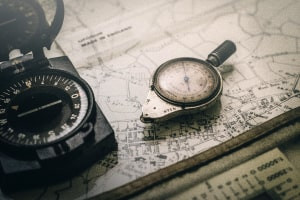Pythagoras first proposed that the Earth’s shape was spherical and Aristotle confirmed this a few centuries later. Aristotle was credited with being the first person to try and calculate the size of the Earth by determining its circumference. This diploma course in terrestrial and coastal navigation will teach you how these great philosophers have helped forge the way for how we navigate today. We explain how you can draw ‘the great circle’ on the surface of a sphere. You can form the spherical triangle on a sphere by using the arcs of three great circles. Understand that planning and monitoring a sea passage uses terrestrial and coastal navigation. We will explain various aids for fixing a vessel’s position or estimating the vessel’s position. We will introduce you to the concept of the Earth axis, an imaginary line that connects the poles of a body. Learn about the equator that divides the Earth into a northern and southern hemisphere. The prime meridian and its anti-meridian form a great circle and divide the world into the eastern and western halves. Discover the format of expressing longitude coordinates, the concept of the geographical, statute and the nautical mile, the idea of the knot, cable and datum.
The course then describes the nautical publications and how to gather important information required during sailing, especially terrestrial coordinates features. Examine how a navigator uses the nautical chart to plot courses and review daily works. Nautical charts are essential for marine navigation, the use of the title block, datum and soundings. Study the difference between the two latitudes and learn how to measure the meridional parts of a given latitude. We summarise the natural scale and use it to determine the relationship between a given distance on the chart and the Earth. Recognise the symbols and abbreviations that can be used on charts and consciously avoid charted dangers during passage planning. Deduce how you can group the symbols and abbreviations under the required headings. You will learn about the features of the notice to mariners, light list, tide and current tables and the coast pilots. We will also cover the essential nautical publications of the United States and the significant admiralty nautical publications.
Become familiar with the Earth’s rotation and how you can use the development of the gyrocompass for marine navigation. You will learn about the directions on the compass card and the gyro error and see how the magnetic compass can be fitted on ships. Grasp the application and significance of position lines and master the various plotting positions on a chart, the source of errors in position lines and position fixes. This course will teach you how to use the horizontal sextant angles in position fixing on a chart. We will uncover the primary position fixing method, position accuracy and the celestial fix before we explain how navigators plot a fix consisting of the intersection of two or more distances. You will also learn about the fix by distance races, visual fixes and how to use a terrestrial charted object’s vertical sextant angle (VSA) to get range and position. This course will greatly appeal to students, researchers and anyone interested in marine navigation. So enrol for this course and start your next learning journey today.
What You Will Learn In This Free Course
View All Learning Outcomes View Less All Alison courses are free to enrol, study, and complete. To successfully complete this Diploma course and become an Alison Graduate, you need to achieve 80% or higher in each course assessment.
Once you have completed this Diploma course, you have the option to acquire an official Diploma, which is a great way to share your achievement with the world.
Your Alison certificate is:
- Ideal for sharing with potential employers.
- Great for your CV, professional social media profiles, and job applications.
- An indication of your commitment to continuously learn, upskill, and achieve high results.
- An incentive for you to continue empowering yourself through lifelong learning.
Alison offers 2 types of Diploma for completed Diploma courses:
- Digital Diploma: a downloadable Diploma in PDF format immediately available to you when you complete your purchase.
- Physical Diploma: a physical version of your officially branded and security-marked Diploma
All Diplomas are available to purchase through the Alison Shop. For more information on purchasing Alison Diploma, please visit our FAQs. If you decide not to purchase your Alison Diploma, you can still demonstrate your achievement by sharing your Learner Record or Learner Achievement Verification, both of which are accessible from your Account Settings.











 Avg. Hours
Avg. Hours  Contains Video
Contains Video  CPD Accredited
CPD Accredited 
 Total XP:
Total XP: 
 Knowledge & Skills You Will Learn
Knowledge & Skills You Will Learn 






